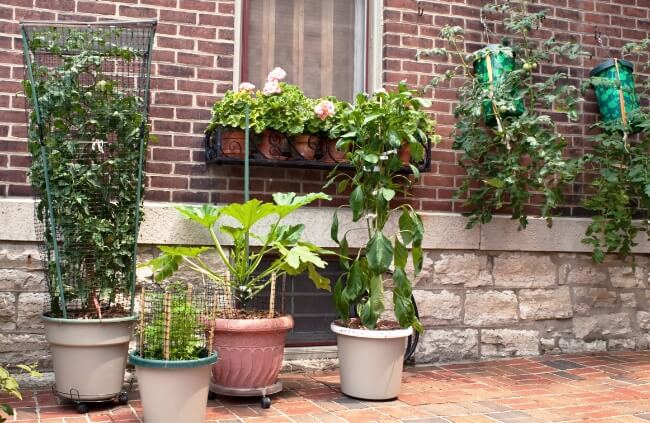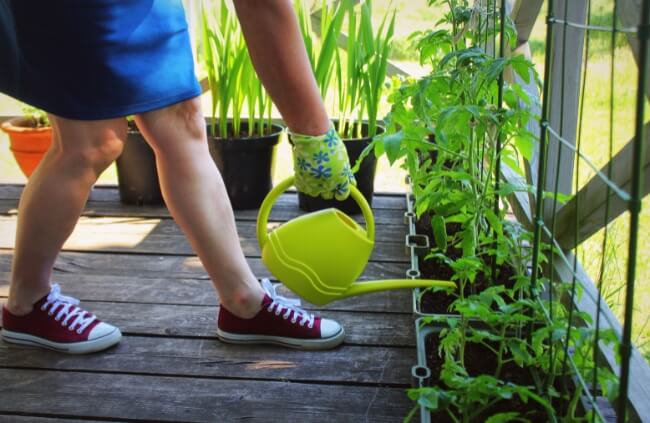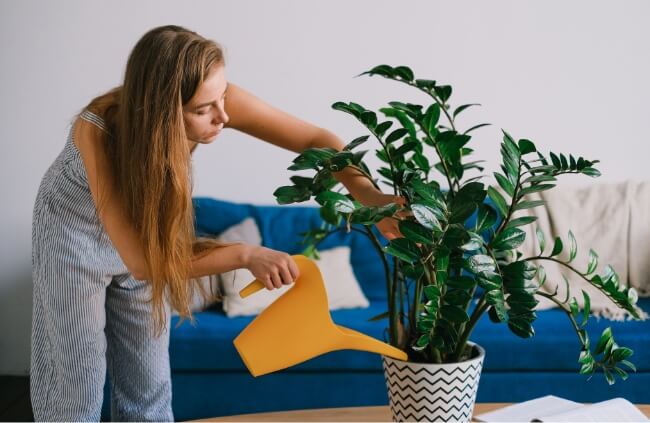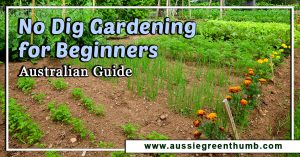Container gardening is becoming more and more fashionable as people’s gardens reduce in size. Even for the gardener with acres of land they are still very popular. The main benefit of container plants is that they allow a gardener to express themselves and change their garden at a whim.
Apart from the increased maintenance and water use there are few points that will help you from keeping your container garden looking fresh. Read on….
More...
Considerations for Container Gardening

Water Retention
The biggest problem many gardeners find with their container plants is for them to dry out in summer and become waterlogged in winter. During the peak of the summer months you may need to water many of your container plants twice every day depending on the size of your plant and the size of the pot.
This is because your plant will transpire naturally, as does your garden plants, but they also lose moisture as there is less soil to hold it.
Fertiliser for Container Gardening
Fertilising your container plants is another area of concern. Because container plants require more water they lose nutrients through the soil quicker than a plant positioned in a garden bed.
Use water-soluble slow release fertilisers in conjunction with a good liquid feed such as liquified worm castings or seaweed extract.
Soil Drainage
Adequate drainage is important to stop your plants' roots rotting. Apart from having a good potting medium that can drain well, on bigger pots try filling the bottom with broken tiles, bricks or even small stones.
Also, lift the pot off the ground with some type of support such as bricks or pot feet so that the container can allow the pot to drain.
Container Vegetable Gardening

While everyone may not have room for full-sized vegetable gardening, many can find a spot in a patio, balcony or rooftop for container vegetable gardening. Even a single container planted with vegetables can provide a bountiful harvest, enough to feed a family of six or host a dinner for six friends.
What You’ll Need To Start Container Vegetable Gardening
Growing food for your family is one reason gardeners are turning to container vegetable gardening.
Sunlight
Most vegetables need at least six hours of full sunlight every day to grow properly. Cool season plants like lettuce, celery and broccoli can get by on a bit less. Setting containers on caddies allows them to be easily moved towards the sun.
Containers
Most vegetables require a pot that is at least 45 cm deep and 60 cm wide. If you don’t have space for large containers, you can still grow shallow root plants, such as lettuce, radishes and peppers, in smaller containers or window boxes.
Remember to consider total weight when choosing a container. A pot filled with wet soil can be heavy.
Soil
Using a soilless potting soil with time-released fertiliser is the easiest way to ensure that your vegetables get the water and nutrients they need. Soilless potting mixes contain a mix of ingredients like compost, perlite, vermiculite and sphagnum peat that help soil absorb and retain water and nutrients. A soilless mix also helps protect vegetables from bacteria and insects.


Get Your Free Guide:
Master Growing Australian Natives eBook
A Must Have Complete Guide for Every Australian Garden
Get Your Free Guide:
Master Growing Australian Natives eBook
A Must Have Complete Guide for Every Australian Garden
Fertiliser
Choosing a soil mix with time-release fertiliser helps vegetables to get a head start, but you’ll want to supplement it with application of fish emulsion every few weeks.
Water
Drip irrigation systems set on automatic timers can make container gardening a breeze, and ensure that plants get all the water they need. If you’re going to hand water vegetables, you need to make sure that the soil never completely dries out.
Check the soil each morning by sticking your finger into the dirt. If the soil is dry past your first knuckle, it’s time to water.
Choose a Combination of Vegetables
Just about any vegetable can be grown in a container, from favourites like tomatoes and peppers, to root vegetables like potatoes and carrots. When it comes to selecting plants for container vegetable gardening, choosing vegetables with a meal in mind can help narrow down the list.
While herbs don’t fall into the vegetable family, including one or two in your planting can help flavour the final dish. Some plants do best on their own in containers, such as potatoes that need space for their tubers to develop.
Several factors need to be considered when growing a number of vegetables in one large container. While many vegetables grow well together, avoid growing those in the same plant family that will compete for the same nutrients.
All plants should share the same basic watering and fertilising schedule. Choosing plants that vary in height and habit helps each plant get its share of sunlight, and provides a more decorative display. Including a trellis for climbers can help extend growing space.
Italian Cooking
Tomatoes, green peppers, chillies, chives and basil are a perfect combination for vegetable gardening in containers. Not only will this combination provide ingredients for aromatic Italian sauces, the plants group together beautifully. Providing a wire cage for the tomato plant helps keep the plant’s growth compact.
Salad Gardening
Lettuce prefers moist, well-draining soil. Herbs like mint and parsley do, too. Grow them together with spinach and chives to provide a variety of choices for salads.
Soups and Side Dishes
Beans, carrots and butternut or acorn squash provide a visual punch in containers, and provide the main ingredients for hearty soups or colourful side dishes, too. Bean plants need to climb. They do well with a trellis, although they will happily wind up a couple of stakes laced with string as well.
Harvest vegetables right before you begin cooking your meal for six. Your friends and family will be delighted by the flavour of fresh-picked vegetables from your container garden.
Container Plants: Water from Base vs. Top

Container plants let you garden even when you don’t have a patch of earth to call your own. Container gardening brings plants up close, adding colour and interest to patios, decks, and porches, and providing indoor rooms with a touch of nature.
Growing plants in containers allows you to maintain control over the quality of soil, and makes it easier to manage weeds and pests. Yet many find it challenging to keep container plants thriving. When container plants go bad, often the culprit is the method of watering.
Most people water plants in containers from the top. Some prefer watering from the bottom. While there are certain circumstances where one method is preferred over the other, it is important to remember that to plants, all that matters is that roots get the moisture they need to thrive, neither too little, nor too much.
Before deciding whether to water from the bottom or from the top, other factors need to be considered. To reach the right balance of moisture, plants need more than water. They need the right soil and the right amount of drainage.
Soil for Container Plants
Ordinary garden soil is generally too heavy for use in container plants. The simplest way to get the right soil mix for container gardening is to purchase potting-soil bags from a nursery or gardening centre.
Potting soil contains sterilised soil, to help prevent diseases and pests, and has the right density for container gardening. Many mixes include water retentive polymers, white granules about the size of rock salt.
Polymers can absorb over a hundred times their weight in water, and act as water storage for the soil, releasing moisture over time. Look for potting soil with time-release fertiliser to make sure plants receive nutrients as well.
Good Drainage
The right potting soil solves most drainage problems, but sometimes even the best soil can clog the pot’s drainage holes. To prevent this from occurring, place a few rocks at the bottom of the container over the holes before planting.
Many gardeners use “shards,” bits of broken clay pots, instead of rocks. Drainage outside the pot is important, too. Even if you choose to water plants from the bottom, it is never a good idea to allow roots to sit in water for long.
For pots with saucers, line the saucers with pebbles or rocks. In containers with no saucers, before adding the soil, line the bottom third of the pot with rocks, pebbles, shards or packing peanuts.
Watering Container Plants from the Top
Since roots sitting in water are prone to rot, watering plants from the top is preferable in most gardening situations. Generally, plants should not be allowed to dry out completely between watering.
Sticking a finger halfway into the soil is an easy way to determine when to water. If the soil feels dry, water. For outside container plants in hot weather, it may be necessary to water every day.
Adding a layer of inactive organic material, such as decorative bark of sphagnum moss, over top of the soil can help the soil retain moisture in hot weather.
(In the past, we recommended using peat/sphagnum moss. However, given its environmental impact, we have shifted our guidance to less impactful alternatives that are just as good or if not better. Check out our guide if you want to learn more about peat moss and its alternatives.)
Watering Container Plants from the Base
There are some cases when bottom watering is appropriate. When starting seedlings, watering from the bottom ensures that the seeds will stay where you plant them. To water seedlings, place the pots in a pan of water, allowing the water to seep up until the soil feels heavy, then remove the pot from the water.
Some gardeners insist that certain plants enjoy wet feet, such as African violets. Just as with seedlings, however, it is important not to let the plants remain in standing water.
Although watering from the bottom is perfectly acceptable, the method does require extra work. Care must be taken not to let roots rot and soil compact from remaining water logged too long. Watering container plants from the top is the easiest and most-preferred method for most gardeners.
Published on June 5, 2023 by Nathan Schwartz
Last Updated on November 21, 2025


